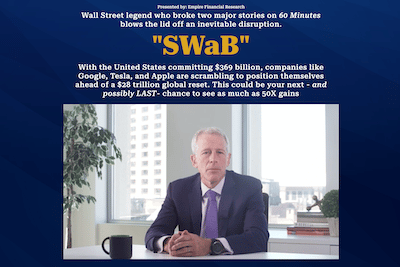In a presentation dubbed “The IPO Opportunity of the Decade,” Jason Simpkins claims there’s a “little-known startup” that’s “expected to give birth to a massive new industry.” And according to Simpkins, the stock could hand investors “up to 8,933% gains.”
As I went through the presentation, I learned that the company Simpkins is bullish on is based in Alameda and specializes in nanosat (small satellite) launches. However, he stopped short of naming the company.
Instead, he reveals it in his “The New Space Age” report, which comes with a subscription to his ($99) stock advisory service, Wall Street’s Proving Ground.
The good news is that this is a legitimate service. But I can understand if you don’t want to pay to find out what Simpkins stock pick is. So, let’s look into the clues he shares in the presentation to see what nanosat stock he might be teasing.
Overview of Jason Simpkins’ “Opportunity of the Decade” Prediction
Jason Simpkins began the “Opportunity of the Decade” presentation by showing three blurred faces that he claims once held “top-level positions” at Apple, Amazon, SpaceX, and Tesla before “secretly” joining a “little-known startup.”
And the reason, according to Simpkins, is because “they all know the next BIG thing is on the horizon” and want to be part of it.
Simpkins later revealed that the “big thing” he’s talking about relates to a “revolution in the satellite industry.”
And as I got further into the presentation, I learned that this so-called “revolution” has to do with small satellites called nanosatellites (nanosats) that he says the company he’s interested in launches into space.
Simpkins points out that satellites once cost up to $400 million to build, that some were the size of a school bus, and that it took months to build one.
However, thanks to technological innovation, satellites are now much smaller, cost less to produce, and can be made in one day.
“They’re called nanosats and are no bigger than a loaf of bread.
Arizona State University recently unveiled a nanosat that’s the size of a half-dollar coin.
Nanosats are much cheaper as well… They cost $1 million or less.
That’s a 99% price reduction in comparison to old space technology.
And they can be built in as little as a day instead of months…”
What’s the big deal?
According to Simpkins, thousands of nanosats will soon be circling the planet and provide super-fast internet, help save lives, provide “ultra-exact” hurricane and glacier warnings, and track aircraft and ships for help in emergencies.
He also points out that nanosats could benefit industries like agriculture, transportation, and defense… virtually any industry you can think of.
However, he also points out that there are “two huge problems” with getting the satellites into orbit.
The first problem is that it’s currently very expensive to launch a satellite. According to Simpkins, the launch cost can “be more than 100X the cost of the satellite itself.”
And he states that rocket launches with the company he’s teasing currently cost $3 million, but this is “expected to go down to just $1 million” in the near future. And he suggests that the cost to launch an individual satellite could come down as low as $100,000.
“And consider that they can put four 100-pound satellites — and a lot more smaller ones — on one single rocket into space…
That comes down to $250,000 per satellite. With 10 smaller satellites, we’re looking at $100,000 per satellite. “
So, the company Simpkins is interested in could solve the first problem if what he says is true. But what about the second problem?
According to Simpkins, the second problem is that right now, “you have to wait for at least two years to get a spot on a rocket to launch your satellite into space.”
It’s hard to verify that claim since numerous companies launch satellites—for example, SpaceX, Blue Origin, and Virgin Orbit, to name a few.
However, Simpkins claims that “demand for satellite launches exceeds the supply of rockets available to carry these satellites by a huge amount.” And he says that never before have this many satellites been qued up for launch, which is a trend he sees continuing.
“Never before in the history of spaceflight have this many satellites queued up for launches.
In 2011, 39 small satellites were put into orbit…
By 2017, there were 338…
And by 2020, the number leaped to more than 1,200.
That’s a parabolic increase of 2,976% in less than 10 years.
This trend is unstoppable…”
According to Simpkins, “12,000 satellites could be in space by 2028.” And it turns out that was possibly an understatement, if anything. According to weforum.org, there could be 15,000 satellites in orbit by 2028 based on an estimate by Euroconsult.
So, where does the “little-known startup” Simpkins talks about fit into all of this? In short, he believes it’s “perfectly positioned to fill this gap.”
“And this company from Alameda is perfectly positioned to fill this gap.
Its mission is to provide the first daily space delivery service in history.
This firm builds rockets faster than anyone else in the industry…
Its rockets are 50 times smaller and it builds 50 times more of them.”
According to Simpkins, the company uses a three-part strategy involving “vertical integration, rapid iteration, and extreme specialization,” which gives it an edge.
On vertical integration, Simpkins says the company builds nearly everything it needs itself, which allows them to offer the most affordable rocket launches for small satellites.
The rapid integration part relates to how the company “builds vehicles, tests them, and flies them as quickly as possible.” According to Simpkins, this is the “same strategy Apple uses to develop products.”
And the last part, extreme specialization, relates to how the company’s “sole focus lies on nanosats,” which Simpkins believes could “account for the majority of the global $271 satellite market.”
So, to sum it up, Simpkins believes that demand for nanosat (AKA small satellite) launches will increase and that the “tiny company” he’s interested in is “at the center of it all.”
What company is he teasing?
Read on.
What Is Simpkins’ Nanosat Stock Pick? (Revealed)
So far, we know that the company specializes in launching nanosatellites and that it’s based in Alameda, California. We also have some hints about its operation.
What other clues does Simpkins share?
One clue he shares is that the company “has at least 50 launches under contract as we speak” and that it’s “planning to do 300 launches per year in 2025.”
Another relates to who’s already invested in it. Simpkins mentions BlackRock, Canaan Partners, Airbus, and Marc Benioff.
“Institutions and rich angel investors have already poured nine figures into this company…
I’m talking about BlackRock, Canaan Partners, Airbus, and Salesforce co-founder Marc Benioff.”
And a third is that “the doors just opened for regular investors like you and me.” In other words, the company went public recently.
But none of those are what led me to solve this puzzle. In the end, it was the clue Simpkins shared about the DARPA’s launch challenge.
“It recently demonstrated this ability during DARPA’s launch challenge.”
[…]
“This company from Alameda came out as the only finalist of this launch challenge.
Beating Richard Branson’s spaceflight empire Virgin Orbit to the punch.”
That led me to an article on spacenews.com about a three-way launch contest between Vector, Virgin Orbit subsidiary Vox Space, and a “stealth” competitor believed to be Astra Space. And the mystery company was the finalist after the other two pulled out.
From there, I researched Astra Space (ASTR), and it’s a match.
Here’s a summary of why:
- First, according to the company website, Astra offers the lowest cost-per-launch dedicated orbital launch service in the world and launches payloads (i.e., satellites) of up to 500kg.
- Second, Simpkins states that one of the founders “used to be NASA’s chief technology officer,” which is true according to the company website.
- Third, he said in the presentation that the “stock trades for less than $10.” As of writing, the share price is just over $3, so that’s a match. As a side note, it was closer to “less than $10” a few months ago. But like many stocks, it has taken a beating recently.
- Lastly, it matches the other clues I mentioned earlier. For example, the company is based in Alameda, BlackRock (etc) has invested, and what he said about the number of launches under contract and the 2025 projection all match.
So, I believe Astra Space (ticker: ASTRA) is Jason Simpkins’ “nanosat” stock pick.
To know for sure what stock he’s teasing and get the research on his nanosat stock pick, you’ll need to access the report he’s put together called “The New Space Age: An Exclusive Guide to a $1 Trillion Opportunity.”
And the only way to get that is to join Wall Street’s Proving Ground. So, in the next section, I’ll give you an overview of what this service is about to help you decide if it’s worth it or not.
Recommended: Go here to see my #1 rated stock advisory of 2024
What Is Wall Street’s Proving Ground?
Wall Street’s Proving Ground is an investment advisory service published by the Outsider Club and edited by Jason Simpkins.
According to Simpkins, the service focuses on helping subscribers benefit from the “biggest, untapped moneymaking trends in the markets.”
The service isn’t limited to any one sector, either. Some of Simpkins’ investment ideas involve tech and space, but he also covers the natural resources sector, defense-related investments, consumer staples, and dividend stocks.
What do you get if you join?
As with most advisories, the core of the service is the monthly newsletter. Each issue provides you with insights and investment ideas from Jason Simpkins. And if you decide you want to follow his ideas, you can do so using your brokerage account.
The service also comes with “Flash Alerts” that are designed to keep you updated on Simpkins’ recommendations and the following three bonus reports:
- The New Space Age: An Exclusive Guide to a $1 Trillion Opportunity
- The 10X Space Infrastructure Gem
- The $12 Billion Satellite Linchpin
Each report covers an investment idea he’s currently interested in.
The first talks about the satellite launching company he’s interested in, which I think is Astra. The second details an “off-the-radar company that’s set to become the dominant player in the debris removal business.” And the third company makes specialized components for satellites that can help them withstand space radiation.
How much does it cost?
One year’s access to Wall Street’s Proving Ground is $99 if you join through the presentation, and according to the Outsider Club website, it comes with a six-month refund policy.
So, that’s the gist of it. And if you want to learn more about the service before joining, see my complete Wall Street’s Proving Ground review.
Who Is Jason Simpkins?
Jason Simpkins joined Outsider Club, a Baltimore-based financial publishing company, in 2013. And he’s now the editor of Wall Street’s Proving Ground.
Before that, Simpkins’ Outsider Club profile states that he was a financial reporter for a different financial publisher. And my research suggests that the company he wrote for was The Agora, a large publisher founded by Bill Bonner in 1978.
How have Jason Simpkins’ stock picks worked out?
I’m not sure how well his picks have worked out since he joined Outsider Club. However, he does cite numerous triple-digit stocks he’s recommended to subscribers, most of which are stocks in the commodities sector.
Bottom Line
After going through Jason Simpkins’ presentation, I believe the company he’s interested in is Astra Space because it matches all of his clues.
Personally, I think it looks like a great company with a bright future ahead, and it’s currently trading at a huge discount from where it was a few months ago.
However, regardless of whether my guess is right, there’s no guarantee you’ll make 8,933% gains or that Simpkins’ pick will help you “turn every $1,000 into $90,330.”
That might be possible, but nobody knows how any stock will do going forward. So I wouldn’t expect that this is what you’ll see by following Simpkins’ investment idea.
As for Wall Street’s Proving Ground, this is a legitimate, low-cost advisory service that caters to investors looking for no-nonsense investment insights. So you might find it to be worthwhile if that’s what you’re looking for.
What do you think? Is the satellite launching sector as promising as Simpkins suggests? And what’s been your experience with Wall Street’s Proving Ground? Let us know below!












Please note: By submitting a comment using the above comment form, you confirm that you agree with the storage and handling of your data by this site as detailed in our Privacy Policy.